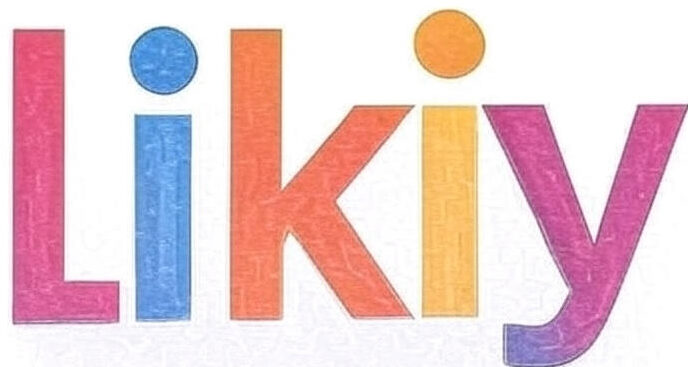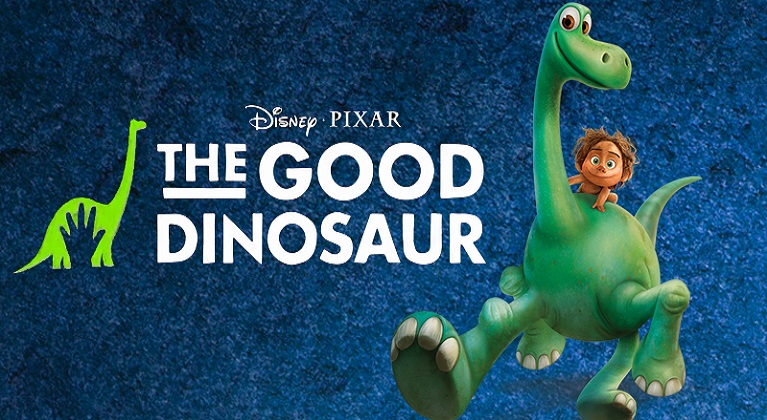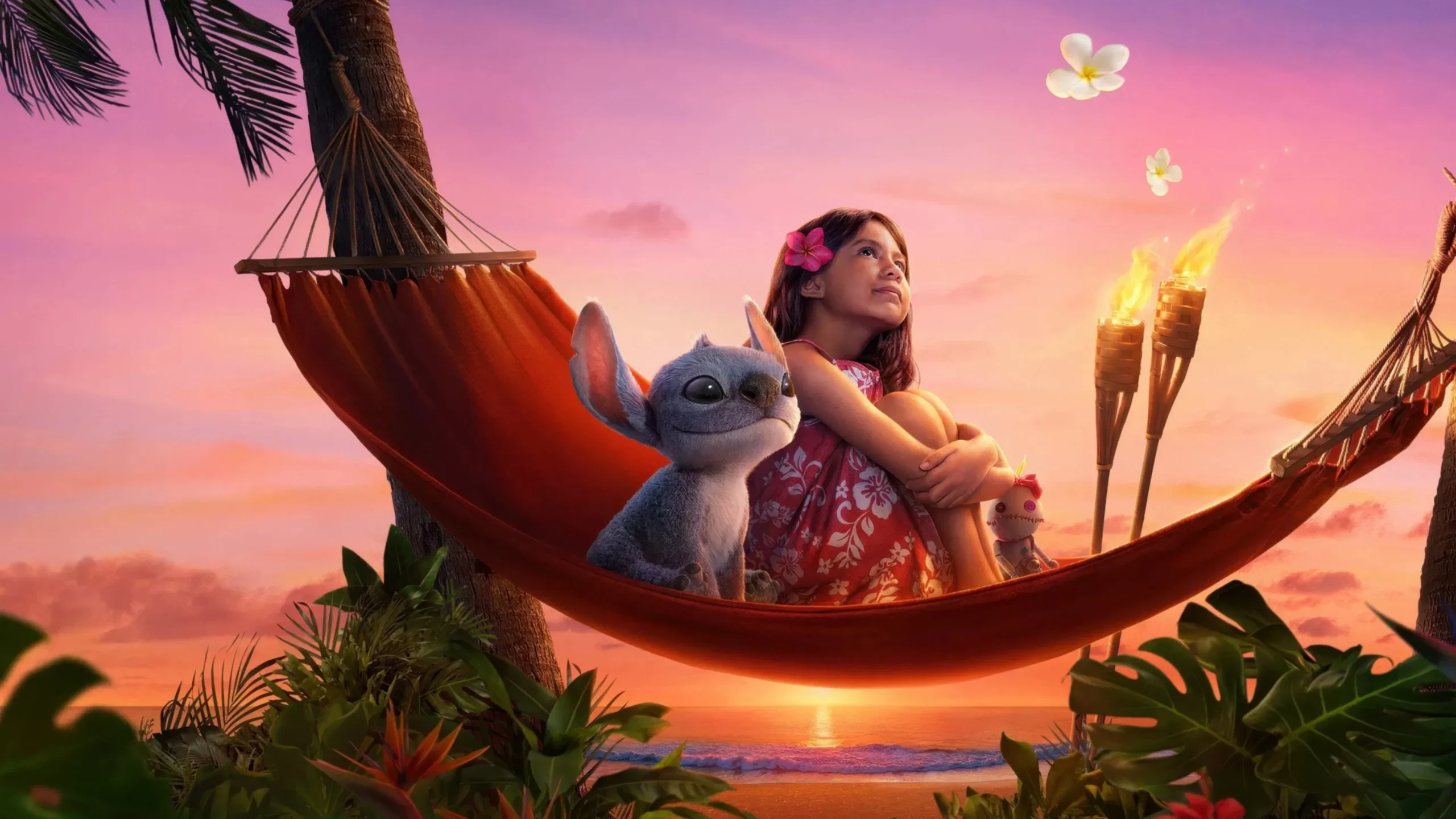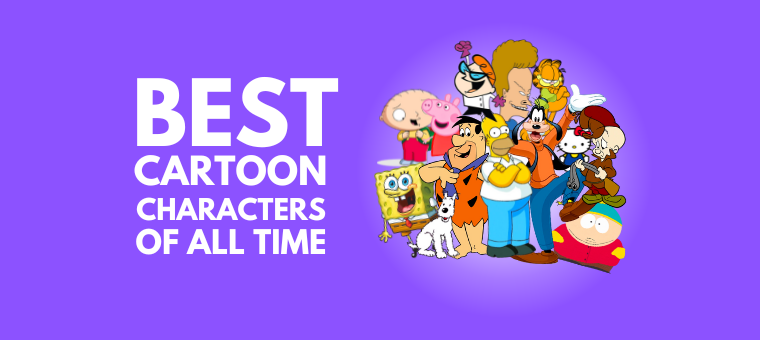Introduction
Pixar’s The Good Dinosaur stands as a unique entry in the studio’s illustrious catalog of animated films, blending heartfelt storytelling with stunning visual artistry. Released in 2015, this feature-length animation transports audiences to an alternate prehistoric world where dinosaurs never went extinct, thanks to a cosmic twist of fate. Directed by Peter Sohn in his feature directorial debut, the film explores themes of family, courage, and self-discovery through the eyes of a young Apatosaurus named Arlo. Unlike many of Pixar’s more urban or fantastical settings, The Good Dinosaur immerses viewers in a vast, untamed wilderness, drawing on the raw beauty of nature to underscore its narrative.
The film’s genesis traces back to Pixar’s commitment to original storytelling, a hallmark that has defined the studio since its inception with Toy Story in 1995. The Good Dinosaur emerged from a desire to reimagine the dinosaur era, not as a realm of ferocious predators and survival-of-the-fittest battles, but as a backdrop for emotional growth and unlikely friendships. This approach sets it apart from other dinosaur-themed animations, such as Disney’s own Dinosaur from 2000, which leaned more heavily into action and realism. Instead, Pixar infused The Good Dinosaur with a sense of wonder and vulnerability, making it accessible to young audiences while offering deeper layers for adults.
At its core, the story revolves around Arlo, a timid dinosaur who must navigate a perilous journey home after a tragic accident separates him from his family. Along the way, he forms a bond with a feral human boy named Spot, flipping the traditional human-pet dynamic on its head. This reversal—where the dinosaur is the “civilized” one and the human behaves like a wild animal—adds a layer of humor and poignancy to the tale. The film’s emotional depth is amplified by its exploration of loss and resilience, themes that resonate universally.
Critically, The Good Dinosaur received mixed reviews upon release, praised for its breathtaking animation but critiqued for a somewhat formulaic plot. Nevertheless, it grossed over $332 million worldwide, solidifying Pixar’s box office prowess. The film’s visual style, characterized by hyper-realistic landscapes juxtaposed with stylized characters, represents a technical milestone for the studio. It pushes the boundaries of computer-generated imagery, creating environments that feel alive and immersive.
In the broader context of animation history, The Good Dinosaur contributes to the evolution of family-friendly films that tackle complex emotions. It joins the ranks of Pixar’s emotionally charged works like Up and Inside Out, yet distinguishes itself with its focus on nature’s majesty. The film’s soundtrack, composed by Mychael and Jeff Danna, complements this with folksy, orchestral tones that evoke the American West, blending adventure with introspection.
As we delve deeper into the film’s elements, it’s clear that The Good Dinosaur is more than just a cartoon—it’s a testament to Pixar’s ability to craft worlds that feel both fantastical and profoundly real. From its intricate production process to its lasting cultural impact, this article will explore every facet of the film, providing a comprehensive look at what makes it a cherished, if underrated, gem in the Pixar library.

Plot Summary
The narrative of The Good Dinosaur unfolds in an alternate timeline where the asteroid that caused the extinction of dinosaurs 65 million years ago misses Earth entirely. As a result, dinosaurs evolve into sentient beings capable of farming, building, and forming societies. The story begins on a rugged farm nestled in the shadow of majestic mountains, where a family of Apatosauruses—long-necked herbivores—tends to their land. The patriarch, Poppa Henry, voiced by Jeffrey Wright, is a strong, wise figure who teaches his children the value of hard work and perseverance. His wife, Momma Ida, voiced by Frances McDormand, provides nurturing support, while their three offspring—Buck, Libby, and the youngest, Arlo—each have distinct personalities.
Arlo, voiced by Raymond Ochoa, is introduced as the runt of the litter, plagued by fear and insecurity. Unlike his bold siblings, who effortlessly earn their “marks” by accomplishing feats that benefit the family farm—such as plowing fields or protecting the silo—Arlo struggles to find his place. His clumsiness and timidity make everyday tasks daunting, and he often hides from challenges rather than facing them. Poppa, sensing Arlo’s potential, assigns him the task of guarding the family’s corn silo from pests, hoping it will build his confidence.
One fateful night, a wild creature raids the silo, stealing corn. Arlo sets a trap and catches the culprit: a feral human boy who behaves more like a dog than a person. Naming him Spot due to his animalistic traits, Arlo initially views him as a nuisance. In a moment of frustration, Arlo blames Spot for his troubles and chases him away, but this leads to a confrontation with Poppa. Determined to teach Arlo bravery, Poppa takes him on a journey along the river to track Spot and confront fears head-on.
Tragedy strikes during a sudden storm. As flash floods rage, Poppa sacrifices himself to save Arlo from being swept away, leaving the young dinosaur devastated and guilt-ridden. Now, with Poppa gone, the family farm falls into a state of mourning. Arlo, overwhelmed by grief, attempts to carry on but finds himself isolated in his sorrow. In another raid on the silo, Arlo pursues Spot once more, but a mishap causes him to fall into the river, washing him far from home.
Waking up in unfamiliar territory, Arlo realizes he’s lost in the wilderness, miles from his family. Injured and alone, he must summon inner strength to survive. Spot reappears, and though their initial interactions are tense—Arlo sees Spot as a wild beast—the boy proves resourceful, helping Arlo find food and water. Gradually, a bond forms between them. Spot, who communicates through grunts and gestures rather than words, teaches Arlo about instinctual survival, while Arlo introduces Spot to concepts of family and empathy.
Their journey home is fraught with perils. They encounter a trio of Pterodactyls led by Thunderclap, voiced by Steve Zahn, who are opportunistic scavengers posing as storm chasers. These villains represent the harsh, predatory side of nature, using religious fervor to justify their ruthless behavior. Arlo and Spot evade them narrowly, showcasing Arlo’s growing courage.
Further adventures introduce colorful characters, such as a Styracosaurus named Forrest Woodbush, voiced by Peter Sohn himself, who collects critters on his horns for protection. This eccentric hermit provides comic relief and imparts wisdom about facing fears. The duo also meets a family of Tyrannosaurus Rex ranchers—Butch, voiced by Sam Elliott, and his children Nash and Ramsey. These rugged cowboys of the dinosaur world herd longhorns (a type of dinosaur) across the plains. Butch, with his gravelly voice and no-nonsense demeanor, becomes a mentor to Arlo, sharing stories of his own scars as badges of survival. In a thrilling sequence, Arlo helps the T-Rexes fend off rustlers—Velociraptors intent on stealing the herd—proving his mettle in battle.
As they press on, Arlo and Spot share poignant moments that deepen their friendship. Using fireflies, Arlo communicates his loss of Poppa, and Spot reveals his own orphan status through a touching, wordless vignette of stick figures. These scenes highlight the film’s emotional core, emphasizing that family transcends species.
Climactic tension builds as another storm approaches, and the Pterodactyls return for revenge. Arlo must choose between fear and heroism, ultimately rescuing Spot from the clutches of Thunderclap. In a heart-pounding chase through flooding rivers and crumbling landscapes, Arlo channels Poppa’s lessons, roaring defiantly to assert his strength.
Finally nearing home, Arlo spots a human family in the distance and realizes Spot belongs with them. In a bittersweet farewell, Arlo encourages Spot to join his kind, marking his own growth from a scared child to a capable individual. Returning to the farm, Arlo reunites with Momma, Buck, and Libby, earning his mark by placing his footprint on the silo alongside Poppa’s. The film closes on a note of hope, with Arlo gazing at the stars, symbolizing enduring legacy.
This detailed plot encapsulates The Good Dinosaur‘s blend of adventure and emotion, clocking in at around 93 minutes of runtime. The story’s structure follows a classic hero’s journey, but Pixar’s touch elevates it with nuanced character arcs and breathtaking set pieces.
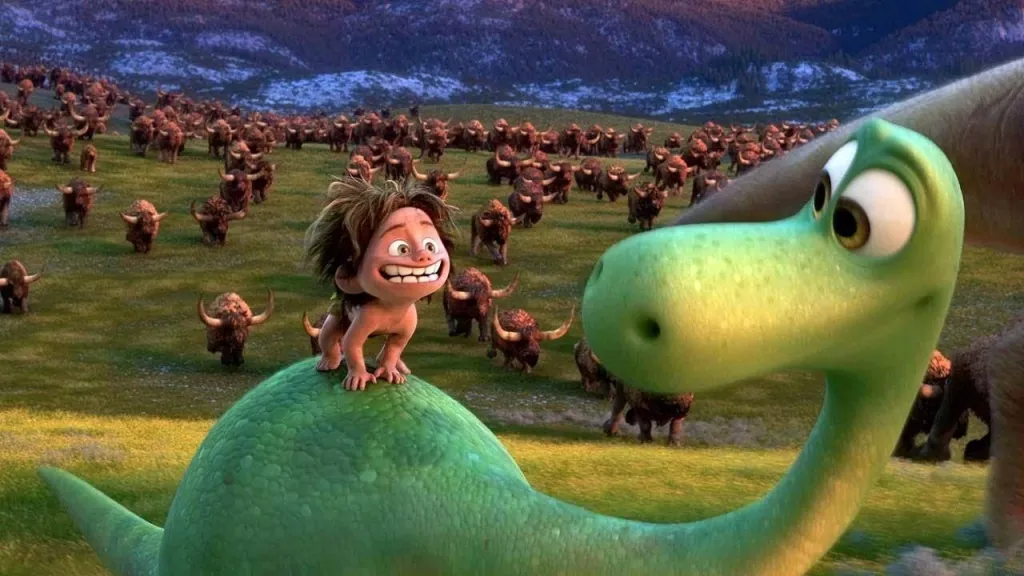
Characters and Voice Cast
The characters in The Good Dinosaur are richly drawn, each contributing to the film’s themes of growth and connection. Arlo, the protagonist, is a young Apatosaurus whose journey from cowardice to bravery forms the narrative spine. Voiced by Raymond Ochoa, Arlo’s performance captures youthful vulnerability, with a trembling voice that evolves into confident resolve. His design—slender, with large expressive eyesemphasizes his initial fragility.
Spot, the human boy, is a standout for his non-verbal communication. Voiced minimally by Jack Bright (mostly grunts and howls), Spot’s animation draws from animal behaviors, making him endearing and feral. This role reversal, where the human acts like a pet, adds humor and heart, allowing for physical comedy and tender moments.
Poppa Henry, voiced by Jeffrey Wright, embodies paternal strength. His deep, reassuring tone conveys wisdom, and his death early in the film sets the emotional stakes. Momma Ida, Frances McDormand’s character, is the steadfast matriarch, her voice warm yet resilient, highlighting maternal endurance.
Siblings Buck and Libby, voiced by Marcus Scribner and Maleah Nipay-Padilla, provide sibling rivalry and levity. Buck’s bravado contrasts Arlo’s timidity, while Libby’s cleverness adds wit.
Antagonists like Thunderclap, voiced by Steve Zahn, bring menace with fanatic zeal. His Pterodactyl cohorts, Coldfront and Downpour (voiced by Mandy Freund and Steven Clay Hunter), amplify the threat.
Supporting characters shine too. Butch, Sam Elliott’s T-Rex, steals scenes with cowboy grit, his scars telling tales of battles won. Nash and Ramsey (AJ Buckley and Anna Paquin) add familial warmth to the ranchers.
Director Peter Sohn voices Forrest Woodbush, injecting eccentricity. Other voices, like Dave Boat as Bubbha the Velociraptor, round out the ensemble.
The voice cast’s chemistry elevates the script, with Elliott’s drawl evoking Western icons and McDormand’s gravitas grounding the family dynamics.
Development and Production
The Good Dinosaur‘s production was a tumultuous journey, reflecting Pixar’s high standards. Conceived in 2009 by Bob Peterson, who initially directed, the film aimed to explore “what if dinosaurs lived today?” Early concepts focused on a boy and his dinosaur, but evolved into the reverse dynamic.
By 2013, production hit roadblocks. Peterson’s vision clashed with studio notes, leading to his removal. Peter Sohn, a storyboard artist on films like Ratatouille, stepped in as director. This shift necessitated major rewrites, delaying release from 2014 to 2015.
Pixar assembled a talented team. Enrico Casarosa, story artist from La Luna, contributed to visuals. Denise Ream produced, bringing experience from Cars 2.
The script underwent revisions to strengthen emotional beats. Early drafts had a more comedic tone, but the final version emphasized grief and growth, influenced by Sohn’s personal experiences with loss.
Animation challenges were immense. Pixar developed new tools for realistic environments, using data from Wyoming and Montana scouting trips. The river sequence alone required simulating millions of water particles.
Voice recording began in 2013, with actors like Wright and McDormand providing input. Spot’s minimal dialogue posed unique challenges, relying on animation to convey emotion.
Budget estimates hovered around $175-200 million, typical for Pixar. The film’s production coincided with Inside Out, sharing resources but stretching the studio.
Despite hurdles, the team’s dedication shone through, resulting in a film that, while not Pixar’s most acclaimed, demonstrates resilience mirroring its protagonist’s arc.
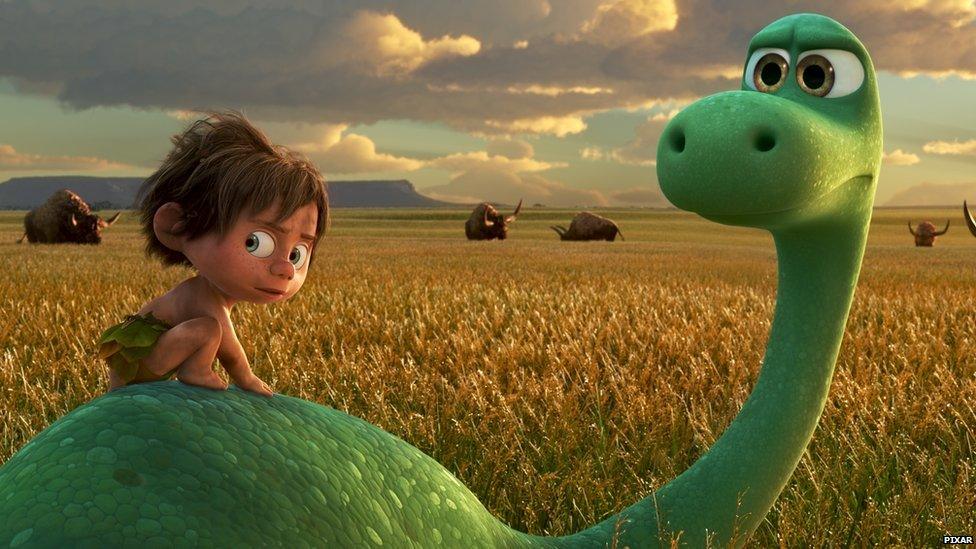
Animation and Visuals
Pixar’s animation in The Good Dinosaur is a triumph of technical innovation and artistic vision. The film employs a hybrid style: hyper-realistic backgrounds contrasted with cartoonish characters. This “caricatured realism” allows dinosaurs to emote expressively while immersing viewers in believable worlds.
Landscapes draw from American Northwest, with the Clawtooth Mountains inspired by the Tetons. Animators used photogrammetry—scanning real terrain—to create digital models, ensuring authenticity. Vegetation simulation involved procedural generation, with millions of plants reacting to wind and light.
Character design balances anatomy with appeal. Arlo’s long neck facilitates expressive poses, his eyes conveying fear or joy. Spot’s human form is stylized feral, with exaggerated movements mimicking dogs.
Key sequences showcase prowess: the storm scene uses advanced fluid dynamics for raging waters, while the firefly moment employs particle effects for ethereal glow.
Lighting and color play narrative roles. Warm farm hues give way to cool, foreboding wilderness tones, symbolizing Arlo’s internal journey.
The film’s 3D release enhances depth, making vast plains feel expansive. Overall, the visuals set a benchmark for environmental animation in family films.
Themes and Messages
The Good Dinosaur delves into profound themes, making it more than mere entertainment. Central is overcoming fear: Arlo’s arc teaches that bravery isn’t absence of fear but action despite it. Poppa’s mantra, “You gotta get through your fear to see the beauty on the other side,” encapsulates this.
Family and loss are pivotal. Poppa’s death explores grief, showing how it shapes identity. Arlo’s bond with Spot redefines family as chosen connections, transcending biology.
Nature’s duality—beautiful yet brutal—is evident in storms and predators, mirroring life’s unpredictability. The film promotes resilience, with scars as symbols of growth.
Friendship across differences highlights empathy. Arlo and Spot’s relationship bridges species, advocating understanding.
Environmental stewardship subtly emerges through the dinosaurs’ farming, suggesting harmony with nature.
These messages, delivered accessibly, make the film educational for children and reflective for adults.
Soundtrack and Score
Composed by brothers Mychael and Jeff Danna, the soundtrack blends orchestral swells with folk influences, evoking vast landscapes. Tracks like “Homestead” feature acoustic guitars and strings, capturing rural life.
The score underscores emotional peaks: somber motifs during loss, triumphant horns in battles. Songs like “Run With the Herd” add energy to action.
No original songs feature, but the instrumental work earned praise for complementing visuals without overpowering.
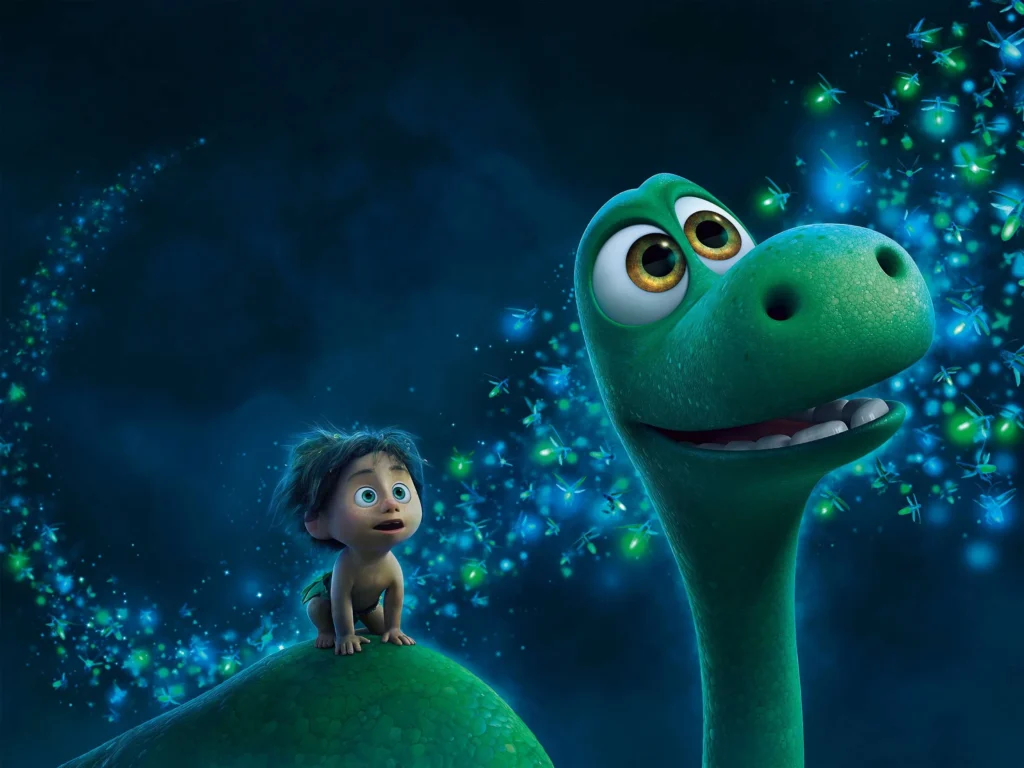
Release and Reception
Released November 25, 2015, The Good Dinosaur faced competition from The Hunger Games: Mockingjay – Part 2. Marketing emphasized adventure, with trailers highlighting visuals.
Box office totaled $332 million against $175 million budget, profitable but Pixar’s lowest-grossing at the time.
Critics gave 76% on Rotten Tomatoes, lauding animation but noting plot familiarity. Roger Ebert’s site called it “visually stunning but narratively safe.”
Awards included Annie nominations for effects and design.
Home media release boosted popularity, with Blu-ray extras detailing production.
Legacy and Impact of The Good Dinosaur
The Good Dinosaur, released by Pixar Animation Studios in 2015, may not have achieved the critical or commercial heights of some of the studio’s juggernauts like Toy Story or Inside Out, but its legacy endures through its unique contributions to animation, storytelling, and cultural resonance. As an underrated gem in Pixar’s catalog, the film has carved out a niche as a cult favorite, appreciated for its emotional depth, technical achievements, and lasting influence on family-friendly storytelling.
Its impact can be seen in its contributions to animation technology, its influence on subsequent films, its role in shaping Pixar’s reputation for risk-taking, and its continued presence in popular culture through merchandise and fan engagement. Below, we explore these aspects in detail to understand how The Good Dinosaur has left a lasting mark.
Technical Innovation in Animation
One of the most significant aspects of The Good Dinosaur’s legacy lies in its groundbreaking animation techniques, particularly its approach to rendering hyper-realistic environments. Pixar pushed the boundaries of computer-generated imagery by creating landscapes that felt almost photorealistic, a feat that set a new standard for animated films. The film’s depiction of the American Northwest—modeled after real-world locations like Wyoming’s Teton Range—was achieved through advanced techniques like photogrammetry, which involved scanning real terrain to create digital models. This allowed for unprecedented detail in elements like rivers, mountains, and vegetation, with millions of plants dynamically reacting to wind and light in real-time simulations.
This technical achievement influenced subsequent animated films across studios, encouraging a trend toward more immersive, naturalistic environments. For instance, Disney’s Moana (2016) and Zootopia (2016) adopted similar approaches to crafting believable worlds, with detailed ecosystems that enhanced storytelling. Pixar itself built on these advancements in later films like Soul (2020), where urban landscapes required similar attention to environmental detail. The tools developed for The Good Dinosaur, particularly for water and foliage simulation, became part of Pixar’s proprietary software suite, benefiting future projects and solidifying the studio’s reputation as an industry leader in animation technology.
The juxtaposition of hyper-realistic backgrounds with stylized, expressive characters also became a hallmark of the film’s visual identity. This “caricatured realism” approach—where Arlo and other dinosaurs have exaggerated, emotive designs while the world around them feels tangible—has inspired animators to experiment with contrasting art styles to balance emotional accessibility with visual immersion. This technique can be seen in later works like DreamWorks’ The Bad Guys (2022), which blends stylized characters with detailed settings.
